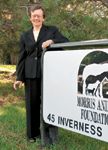An Interview with... Dr. Patricia N. Olson
Many important issues are facing the veterinary profession, but veterinarians should not be daunted, says this leader of a foundation charged with improving the lives of companion animals and wildlife. "Be persistent in what you believe in, and don't give up."
Patricia N. Olson, DVM, PhD, is the president/CEO of Morris Animal Foundation. She was previously the director of canine health and training at Guide Dogs for the Blind and won the Bustad Companion Animal Veterinarian of the Year award in 1998 and The Geraldine R. Dodge Foundation Humane Ethics in Action Award in 1996.
What is the most exciting change you've seen in veterinary medicine?
The advances in companion-animal veterinary medicine. When I was a veterinary student, the focus was on the livestock industry, not dogs and cats. This change in veterinary medicine isn't just good for the animals, it's good for human health and well-being as well.
Who was your most memorable patient?
Freddy, a cat, was the most memorable because I was criticized—even by some colleagues—for continuing to try to diagnose his unusual disease rather than euthanize him. Eventually the correct diagnosis was made, and Freddy was treated successfully. What that said to me was to be persistent in what you believe in and don't give up, whether that's managing a patient that has a curable disease or trying to obtain funding for health studies that benefit animals.
Who inspired you most in your career?
Warren Liebenstein, a Rice County agent and my mentor through my 4-H years in Minnesota. Some well-meaning people had told me that women couldn't be veterinarians, but he encouraged me. He helped me with 4-H projects, and years later he gave me best wishes when my husband and I opened the doors of our first veterinary clinic in his county.

I hope that veterinarians will become the ultimate advocates for animal welfare.
What was the best professional advice you ever received?
In life we are responsible for our efforts but not the outcome. You have to expend considerable effort, but also remember that you can't always be responsible for the outcome.
What would you advise a new graduate?
New graduates have many opportunities. They can work with the government, the airline industry, animal welfare issues, public health, individual animal patients, nonprofits, or pharmaceutical companies. The opportunities are phenomenal. That's what is so amazing about this profession—the opportunity to do so many things to promote animal and human health.
One such opportunity for you must have been working with Guide Dogs for the Blind. What did you learn from that experience?
I learned that many disciplines can come together to make life better for both animals and people. Physicians, nurses, professional guide dog trainers, veterinarians, geneticists, and many others worked collaboratively to improve the lives of guide dogs and, in doing so, improved the lives of blind Americans.
Are you a cat person or a dog person?
Our family has had cats and dogs, so I would say that I am both. Currently, I have two dogs, Emma and Socrates. Our family recently lost a cat, Fungus, who had been with us more than 17 years. The kids named her Fungus because she was abandoned in front of our house covered in ringworm.
What book would you recommend?
My favorite professional book is Mark Morris: Veterinarian by Willard C. Haselbush because it describes a visionary veterinarian who persisted in believing that dogs and cats should receive innovative therapies. I also love Main Street by Sinclair Lewis, which tells a story of a woman who finds herself and her voice and, in doing so, loves her family even more.
What is your favorite film?
Winged Migration because of the beautiful photography showing the migratory patterns of birds all over the planet. I saw it on the big screen, and it was phenomenal.
What favorite musicians would you include on your personal jukebox?
I would have to say the Beatles. They are in my personal jukebox. I'd also like to add that my favorite artist is Dutch painter Judith Leyster, the first woman admitted to the Dutch artist guild. My favorite painting of hers is Self-Portrait.
What part of your work do you enjoy most?
Relative to Morris Animal Foundation, it's the opportunity to help all animals and to do so with a dedicated staff and trustees and Foundation friends who all share that goal. I can go home each day and say, "Today I worked to help the animals on our planet." That's so cool.
What do you consider the greatest threat to the profession?
The possibility of losing our humanity. According to Gallup polls, veterinary medicine is one of the most trusted professions. We need to make a good income, but we can't become so driven by the dollar that animals receive less care.
Which animal health needs are currently unmet?
Many needs aren't being met. At Morris Animal Foundation, we're interested in cancer and are building a consortium to work on this problem. I've also devoted much of my professional life to solving pet overpopulation. Wildlife species also face huge challenges. Although these animals may not come to a veterinary clinic, as a profession we're responsible for endangered species.
What changes in veterinary medicine do you hope will occur in the next 100 years?
Genetic technologies may be used to diagnose and treat disease. We could tailor individual therapies based on unique genetic profiles. I hope that veterinarians will become the ultimate advocates for animal welfare and will lead the way in establishing innovative ways of preventing and curing disease.